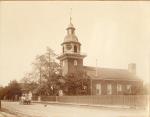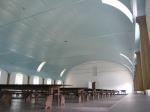![header=[Marker Text] body=[Constructed, 1828-1831, with bricks made by the Society members, this is the second building erected for worship. It is believed designed by Frederick Rapp. The spiritual life of the Society centered here.
] sign](kora/files/1/10/1-A-4E-139-ExplorePAHistory-a0a2y9-a_450.gif)
Mouse over for marker text
Name:
Harmony Society Church
Region:
Pittsburgh Region
County:
Beaver
Marker Location:
Church Street near Creese Street, Ambridge
Dedication Date:
September 11, 1967
Behind the Marker
The Harmony Society Church is located in the town of Ambridge, at the site of  Economy, the second settlement of the Harmony Society in Pennsylvania. Here, the followers of German mystic George Rapp devoted themselves to communal living, hard work, and prayer in preparation for the Second Coming of Christ; an event that they believed was imminent.
Economy, the second settlement of the Harmony Society in Pennsylvania. Here, the followers of German mystic George Rapp devoted themselves to communal living, hard work, and prayer in preparation for the Second Coming of Christ; an event that they believed was imminent.
After moving to Economy in 1825, the German settlers decided to build a stately, strong, and sturdy church made of bricks they themselves would produce. They were eager to complete this project, for according to their leader Johann George Rapp's reading of the Book of Revelations, Christ would appear among them and establish his kingdom on earth in 1829. Construction of the new church, however, took longer than expected; started in 1828, it was not finished until 1831.
Women and men worshiped on separate sides of the building, so the new church had two elaborately constructed doors on opposite sides, one for women and the other for men. When Jesus did not arrive as Rapp had predicted, the Harmonists were disappointed, but continued to anticipate his arrival at any moment.
The Harmonists also constructed a Feast Hall, which became the center of their community. On the first floor they housed a natural history museum. A large room on the second floor could seat several hundred people. Here, the faithful met for liebesmahl, or love feasts, held on Easter, Christmas, and other Christian holidays. These joyful feasts, often accompanied by music and song, were always followed by a church service, led during his lifetime by the Harmonists' founder, George Rapp.
The Harmonists participated in religious services twice daily. Rapp was an authoritarian and by most accounts an extraordinarily charismatic leader. In the church at Economy, the Harmonists prepared to meet the Savior, sang hymns they had written themselves, and listened to Rapp deliver long sermons about the importance of remaining chaste and pious in anticipation of the time, soon, when Jesus would walk among the faithful. One of his followers recalled the "flow of mystic, transcendental eloquence that sweeps beyond all bounds of the imagination."
After Rapp passed away in 1847 at the age of eighty-nine, his dwindling flock continued to wait, God-fearing and resolute, for the fulfillment of his prophecy.
The Harmonists continued to worship in their church until they numbered only three souls. At the beginning of the twentieth century, the Harmonist Society dissolved, and its property and assets were sold. Although the Harmonists are no longer in existence, their church is still in use as a house of worship by the Lutheran Church, the very denomination against which the Harmonists rebelled. The former Harmony Society Church is now St. John's Lutheran Church.
After moving to Economy in 1825, the German settlers decided to build a stately, strong, and sturdy church made of bricks they themselves would produce. They were eager to complete this project, for according to their leader Johann George Rapp's reading of the Book of Revelations, Christ would appear among them and establish his kingdom on earth in 1829. Construction of the new church, however, took longer than expected; started in 1828, it was not finished until 1831.
Women and men worshiped on separate sides of the building, so the new church had two elaborately constructed doors on opposite sides, one for women and the other for men. When Jesus did not arrive as Rapp had predicted, the Harmonists were disappointed, but continued to anticipate his arrival at any moment.
The Harmonists also constructed a Feast Hall, which became the center of their community. On the first floor they housed a natural history museum. A large room on the second floor could seat several hundred people. Here, the faithful met for liebesmahl, or love feasts, held on Easter, Christmas, and other Christian holidays. These joyful feasts, often accompanied by music and song, were always followed by a church service, led during his lifetime by the Harmonists' founder, George Rapp.
The Harmonists participated in religious services twice daily. Rapp was an authoritarian and by most accounts an extraordinarily charismatic leader. In the church at Economy, the Harmonists prepared to meet the Savior, sang hymns they had written themselves, and listened to Rapp deliver long sermons about the importance of remaining chaste and pious in anticipation of the time, soon, when Jesus would walk among the faithful. One of his followers recalled the "flow of mystic, transcendental eloquence that sweeps beyond all bounds of the imagination."
After Rapp passed away in 1847 at the age of eighty-nine, his dwindling flock continued to wait, God-fearing and resolute, for the fulfillment of his prophecy.
The Harmonists continued to worship in their church until they numbered only three souls. At the beginning of the twentieth century, the Harmonist Society dissolved, and its property and assets were sold. Although the Harmonists are no longer in existence, their church is still in use as a house of worship by the Lutheran Church, the very denomination against which the Harmonists rebelled. The former Harmony Society Church is now St. John's Lutheran Church.







